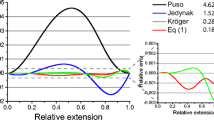Abstract:
Variational methods are applied to a single polyelectrolyte chain. The polymer is modeled as a Gaussian chain with screened electrostatic repulsion between all monomers. As a variational Hamiltonian, the most general Gaussian kernel, including the possibility of a classical or mean polymer path, is employed. The resulting self-consistent equations are systematically solved both for large and small monomer-monomer separations along the chain. In the absence of screening, the polymer is stretched on average. It is described by a straight classical path with Gaussian fluctuations around it. If the electrostatic repulsion is screened, the polymer is isotropically swollen for large separations, and for small separations the polymer correlation function is calculated as an analytic expansion in terms of the monomer-monomer separation along the chain. The electrostatic persistence length and the electrostatic blobsize are inferred from the crossover between distinct scaling ranges. We perform a global analysis of the scaling behavior as a function of the screening length and electrostatic interaction strength , where is the Bjerrum length and A is the distance of charges along the polymer chain. We find three different scaling regimes. i) A Gaussian-persistent regime with Gaussian behavior at small, persistent behavior at intermediate, and isotropically swollen behavior at large length scales. This regime occurs for weakly charged polymers and only for intermediate values of the screening length. The electrostatic persistence length is defined as the crossover length between the persistent and the asymptotically swollen behavior and is given by and thus disagrees with previous (restricted) variational treatments which predict a linear dependence on the screening length .ii) A Gaussian regime with Gaussian behavior at small and isotropically swollen behavior at large length scales. This regime occurs for weakly charged polymers and/or strong screening, and the electrostatic repulsion between monomers only leads to subfluent corrections to Gaussian scaling at small separations. The concept of a persistence length is without meaning in this regime. iii) A persistent regime , where the chain resembles a stretched rod on intermediate and small scales. Here the persistence length is given by the original Odijk prediction, , if the overstretching of the chain is avoided. We also investigate the effects of a finite polymer length and of an additional excluded-volume interaction, which modify the resultant scaling behavior. Applications to experiments and computer simulations are discussed.
Similar content being viewed by others
Author information
Authors and Affiliations
Additional information
Received 24 December 1997
Rights and permissions
About this article
Cite this article
Netz, R., Orland, H. Variational theory for a single polyelectrolyte chain. Eur. Phys. J. B 8, 81–98 (1999). https://doi.org/10.1007/s100510050671
Issue Date:
DOI: https://doi.org/10.1007/s100510050671




